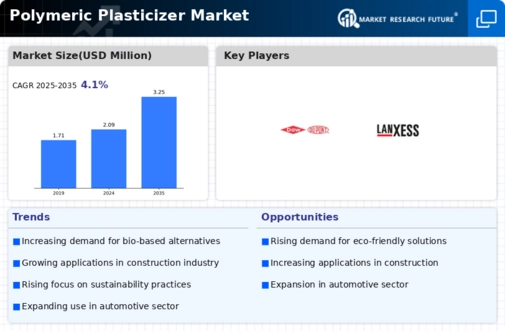Market Growth Projections
The Global Polymeric Plasticizer Market Industry is projected to experience robust growth, with estimates indicating a rise from 2.09 USD Million in 2024 to 3.25 USD Million by 2035. This growth trajectory suggests a compound annual growth rate (CAGR) of 4.1% from 2025 to 2035, reflecting increasing demand across various applications. The market's expansion is likely driven by factors such as technological advancements, regulatory support for sustainable practices, and rising applications in diverse industries. These projections highlight the potential for significant market development in the coming years.
Growing Demand for Eco-Friendly Products
The Global Polymeric Plasticizer Market Industry experiences a notable shift towards eco-friendly products, driven by increasing consumer awareness regarding environmental sustainability. As industries strive to reduce their carbon footprint, the demand for bio-based plasticizers is on the rise. This trend is particularly evident in the construction and automotive sectors, where manufacturers are seeking alternatives to traditional phthalate-based plasticizers. The market is projected to reach 2.09 USD Million in 2024, reflecting a growing preference for sustainable materials. This shift not only aligns with regulatory frameworks but also caters to consumer preferences, thereby enhancing the market's growth trajectory.
Technological Advancements in Production
Technological innovations play a crucial role in shaping the Global Polymeric Plasticizer Market Industry. Advances in production techniques, such as the development of high-performance plasticizers, are enhancing product efficiency and performance. For instance, the introduction of new synthesis methods allows for the creation of polymeric plasticizers with improved compatibility and lower volatility. These advancements are expected to contribute to a compound annual growth rate (CAGR) of 4.1% from 2025 to 2035. As manufacturers adopt these technologies, they can meet the evolving demands of various applications, including coatings, adhesives, and sealants, thereby driving market expansion.
Rising Applications in Diverse Industries
The versatility of polymeric plasticizers is a key driver for the Global Polymeric Plasticizer Market Industry, as they find applications across various sectors, including construction, automotive, and consumer goods. Their ability to enhance flexibility, durability, and processing characteristics makes them indispensable in manufacturing processes. For example, in the construction industry, polymeric plasticizers are utilized in concrete formulations to improve workability and reduce water content. This widespread applicability is expected to sustain market growth, as industries continue to seek high-performance materials that meet specific requirements, thereby solidifying the market's position.
Regulatory Support for Sustainable Practices
Regulatory frameworks globally are increasingly supportive of sustainable practices, significantly influencing the Global Polymeric Plasticizer Market Industry. Governments are implementing stringent regulations on the use of harmful substances, prompting manufacturers to seek safer alternatives. This regulatory environment encourages the development and adoption of non-toxic polymeric plasticizers, which are gaining traction in various applications. As a result, the market is expected to grow, reaching 3.25 USD Million by 2035. The alignment of industry practices with regulatory requirements not only enhances product safety but also fosters innovation, further propelling market growth.
Increasing Investment in Research and Development
Investment in research and development is a significant driver for the Global Polymeric Plasticizer Market Industry. Companies are allocating substantial resources to innovate and improve product formulations, focusing on enhancing performance and sustainability. This trend is evident in the development of new polymeric plasticizers that offer superior properties, such as lower migration rates and improved thermal stability. As R&D efforts intensify, the market is likely to witness the introduction of advanced products that cater to emerging consumer needs. This focus on innovation not only strengthens competitive positioning but also contributes to the overall growth of the market.





Leave a Comment